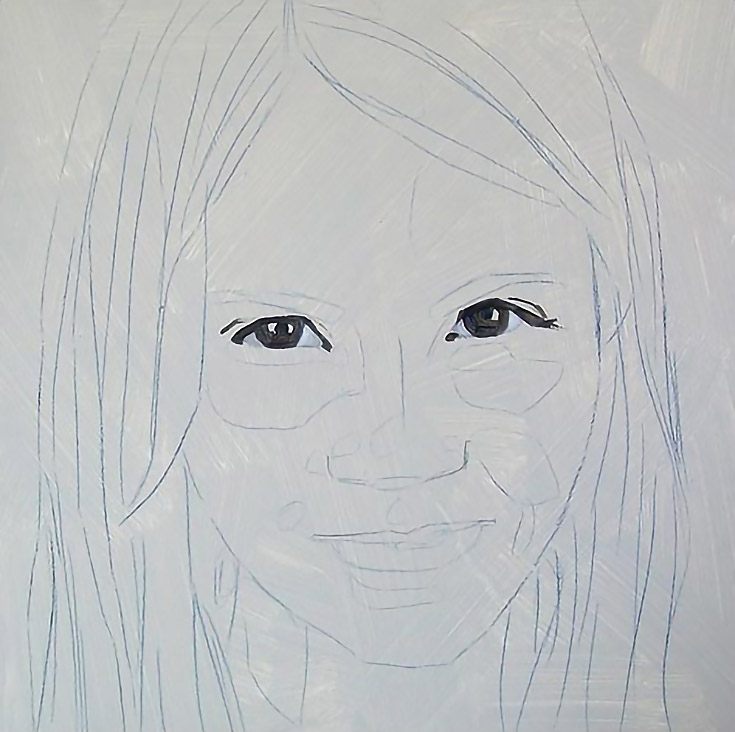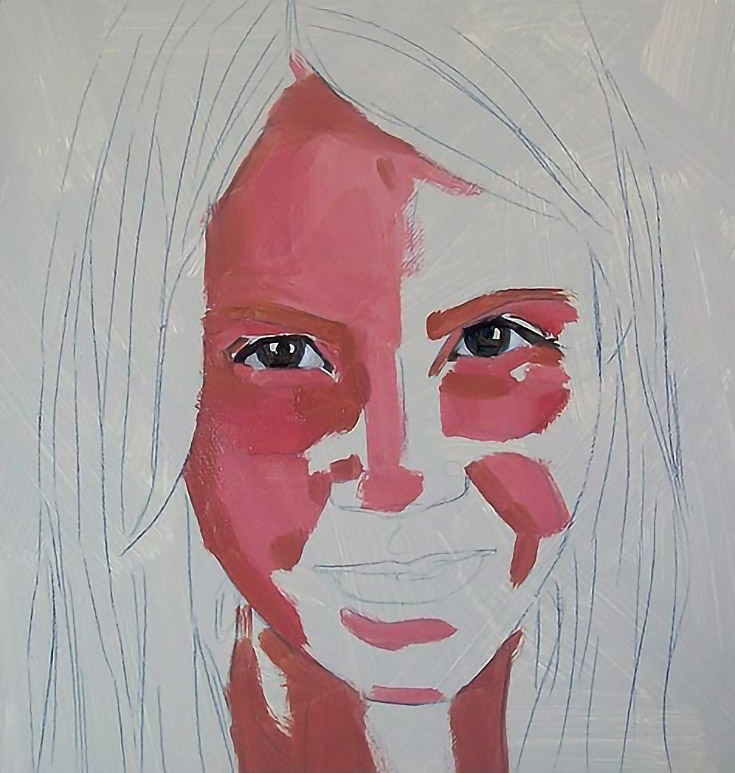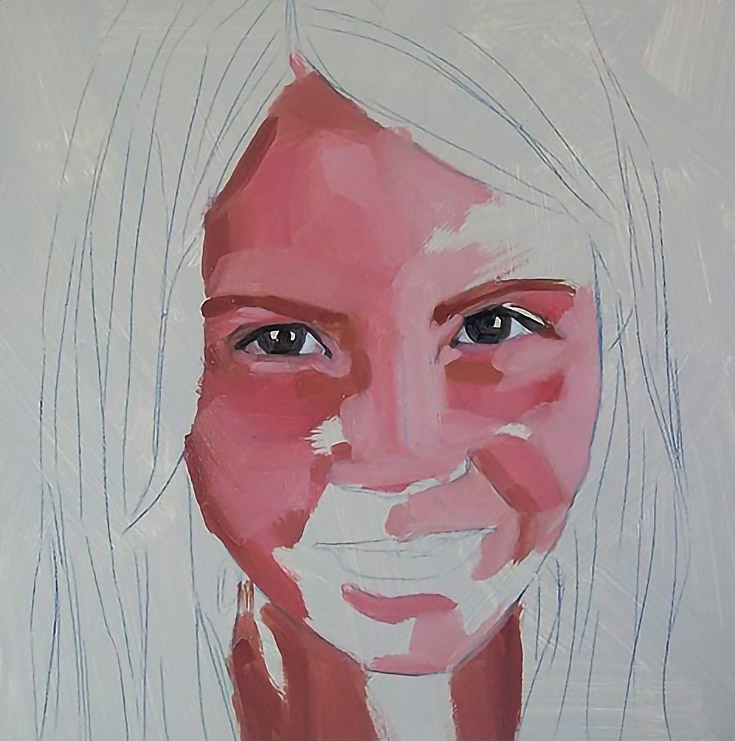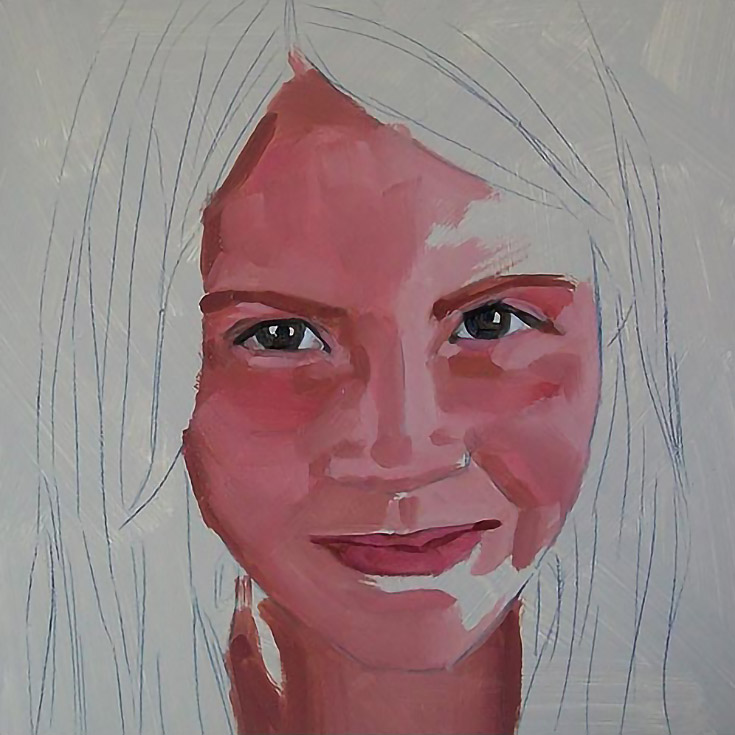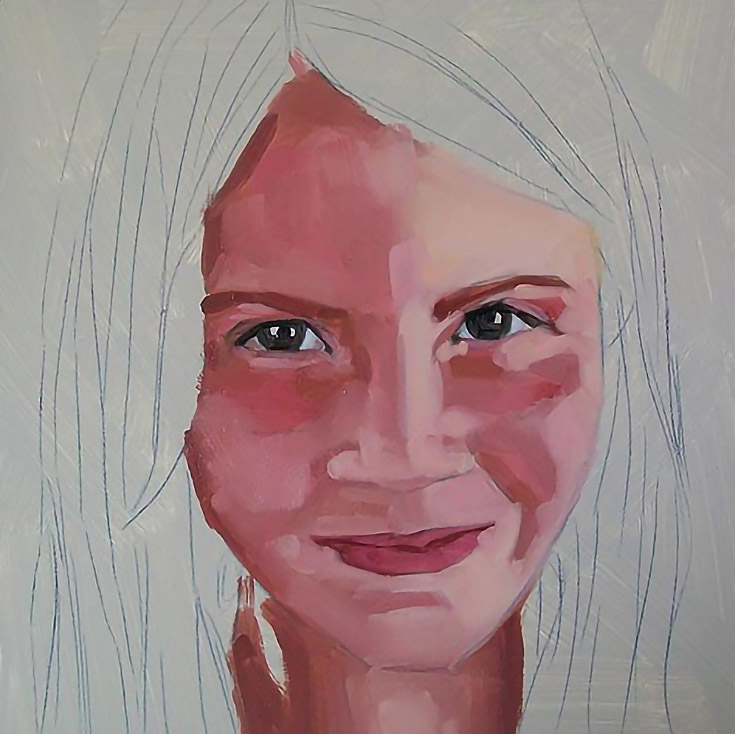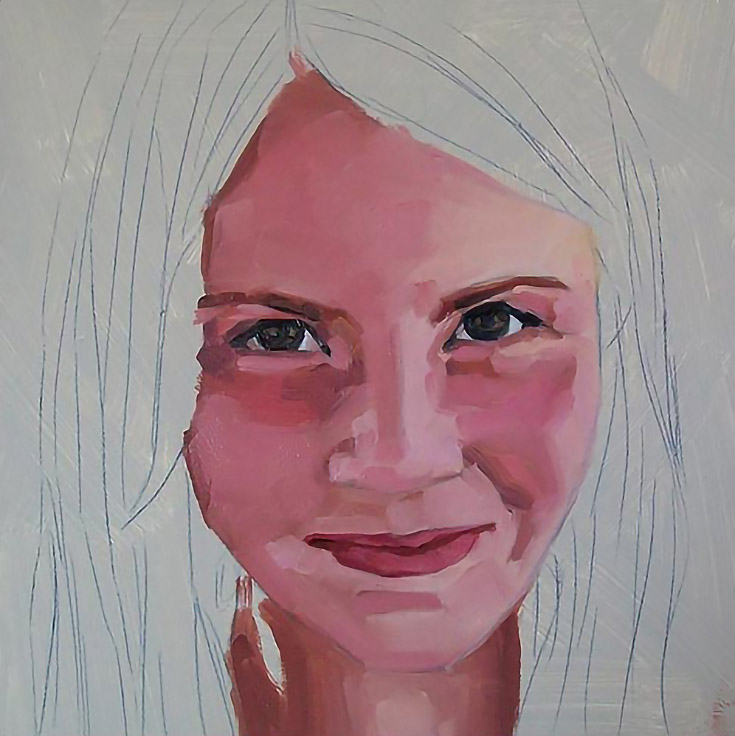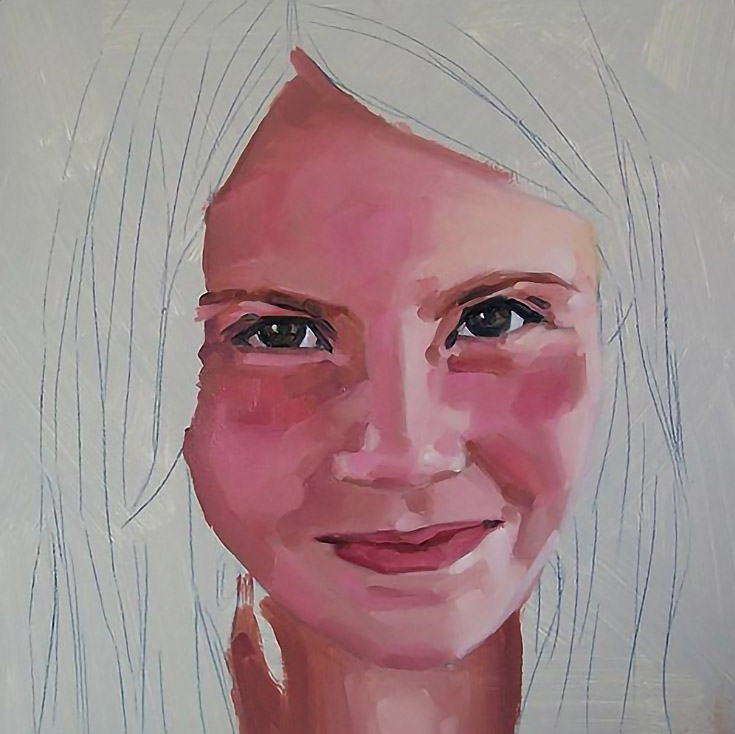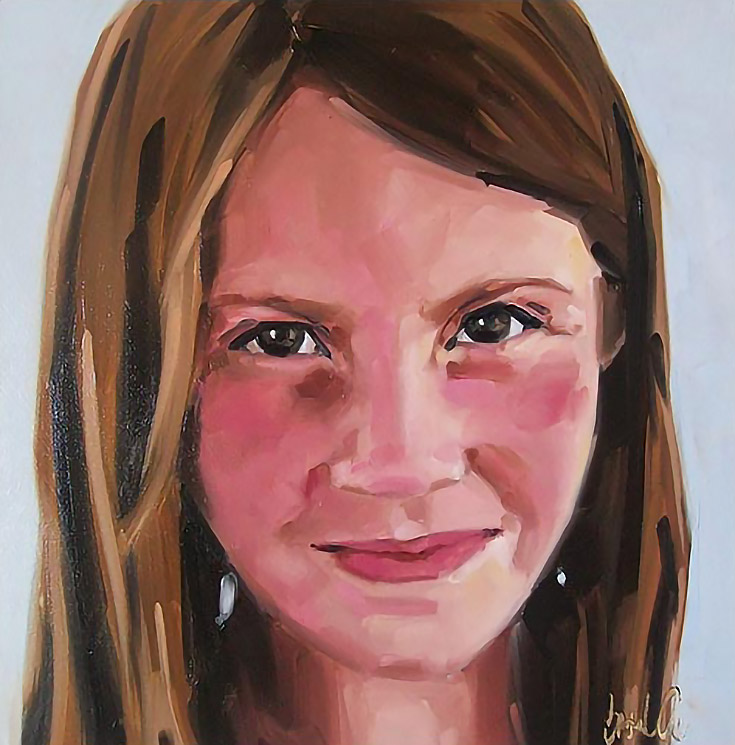I used to be intimidated by portrait painting. I could never get the colors right and I always felt like I ended up drawing with my paint rather than painting.
I decided to tackle portrait painting head-on, and after a lot of practice, I now feel very comfortable painting portraits. Here are the steps I’ve developed to paint a successful portrait from a photo:
1. Choose a photo with great highlights and shadows

When you can’t take your own photograph, try to choose a photo with a range of value from light to dark. (This photo was not one of my own, but it was taken outside and had a good balance of value.)
Pose your subject so there are some shadow areas on the face—this adds dimensionality to the painting. Don’t use a flash or you will lose all the good color and “flatten” out your subject
Once I have my image I always crop it to the size of the canvas or panel that I’ll be painting on. In this case, my panel is 6×6 inches, so I cropped my image to that size and printed it out for my reference.
2. Sketch or trace the image onto your support
If you aren’t comfortable drawing your portrait free hand, don’t be afraid to trace or use a projector to get your proportions correct.
In my own sketches, I like to mark where the shadows and highlights go as well. Think in shapes and not lines, and block in the basic shapes where the shadows and highlights will go.
3. Lay out ONLY the colors you need for your palette
I have found that the following five colors are all you need for most skin tones: french ultramarine, titanium white, alizarin crimson, yellow ochre, and burnt umber. You can order these colors individually from Blick, or find them at your local art supply store.
I also like to use linseed oil to increase the flow of the paint. Pour a small amount into a plastic container and keep it close to your palette. I will dip just a corner of my brush in it to help with mixing colors. Try not to use too much or your paint will get transparent.
4. Start by painting the eyes
I start my paintings by filling in the whites of the eyes first. It’s VERY important to realize that they are never pure white—there are always shadows and variations in the white part of the eye!
In this case, I started with white and added a little ultramarine and umber. (I even dabbed some color onto the reference photo to make sure I was close.)
Once you’re done with the whites of the eyes, fill in the pupils. I left the highlight areas open on this one, but you don’t have to do that if you don’t want to. Highlights will be added at the end, and you can always layer paint over the top to create them.
Don’t get too hung up on the eyes—get the basics in and move on!
5. Block in your shadows and darks
I have found that blocking in the darks first helps me to get a feel for the shapes in the face. For this painting, I started with crimson, yellow, umber, and white.
Again, feel free to mix your color, then dab a little bit right onto your photo to make sure the colors are close. Skin tones will vary and they are never the same all over the face, so keep mixing and dabbing as you paint.
6. Add midtone colors to the portrait
You want to generally work from dark to light, so if your darks are in place, add your midtones. As you do, keep your eyes open for subtle changes in color around the face. For cooler tones, mix a little ultramarine into your skin color to cool it down. For warmer tones, add yellow or crimson.
As you block in the midtones you will see planes of the face take shape. For this painting, I added the lips during this stage as well. Remember, lips are ALSO a skin tone, they are never just red! Mix and dab to be sure of color.
7. Paint the lightest colors on top
Light tones should be your top layer. DON’T use plain white. The light areas of a face are always either a bit cool or a bit warm, so mix your paint accordingly. In this painting my light areas are pretty warm, so I mixed a peachy color with mostly crimson, yellow, umber and white.
When the lights are blocked in you should see a three-dimensional face take shape. Now comes the fun part!
8. Add definition and details throughout the portrait
Now that you have your basic values blocked in, start to play with the tones and make adjustments. Add darks and lights where needed, and always be thinking about ending up with a nice amount of contrast.
You can see where I added some dark mauve colors to define the eye area and deepen the creases near the mouth. I also added more color to the cheeks and lips (see image below) for more definition.
As you fill in various details, remember to keep painting the shapes of the face, not the lines. This is why it makes sense when we say “block in” a color because you’re adding a shape at a time, not drawing around the shapes with paint.
Check your reference photo often, and when you see a difference between your painting and the photo, “fix” it with your paint. This is the most fun part of the painting because the subject almost seems to come alive in front of you!
9. Add the basic colors for the hair and build up
Again I like to start with the dark part of the hair first and layer up to the light areas.
As soon as you block in the dark of the hair you will notice where more color needs to be added to the face. In this case, I needed to add some to the forehead, and the left side along the hairline and the neck.
Next, fill in the rest of the hair. Brown hair can be tricky. Don’t just add white to burnt umber to get a light brown; it turns gray. (The more you can avoid using white or black to lighten or darken your colors, the more vibrant and realistic your painting will be.)
I used umber and ultramarine for the darkest parts, umber and a little crimson for the midtone, and yellow, crimson, and a little white for the lightest strands.
10. Finish up with your highlights and tiniest details
This is where you adjust the details and add highlights where the light touches the hair and reflects in the eyes. You only need a few highlights so don’t get carried away.
In this painting, I added the light in the eyes, a bit on the right side of the nose, and some light strands of hair. These little touches don’t take too much time, and they really help to finish the painting.
Here is a quick tip for creating even more accurate detail in your paintings. By making sure you have the proper lighting for painting, it will make a world of difference in the final result.
It isn’t so important that you have white light or yellow light. The more important quality is creating consistently bright light. You can learn more about the importance of lighting in our How to Draw EXACTLY What You See Guide and how to achieve it.
If you want to fix your lighting or create a better painting environment, I personally recommend these lights from Amazon.
11. Paint in your background
In most of my portraits, the backgrounds are minimal. I like to crop in pretty tight on my subject and block in a color to keep it simple.
If you haven’t already painted your background, try to choose a color that doesn’t compete with your subject and add it around the portrait. If you block in a color and you don’t like it, just wipe it off and use another. In this case, I used white and ultramarine.
Like anything else, the more you practice the more you’ll learn about painting portraits and the better you’ll get, but I hope these tips will help along the way.
Happy painting!
This post may contain affiliate links.

